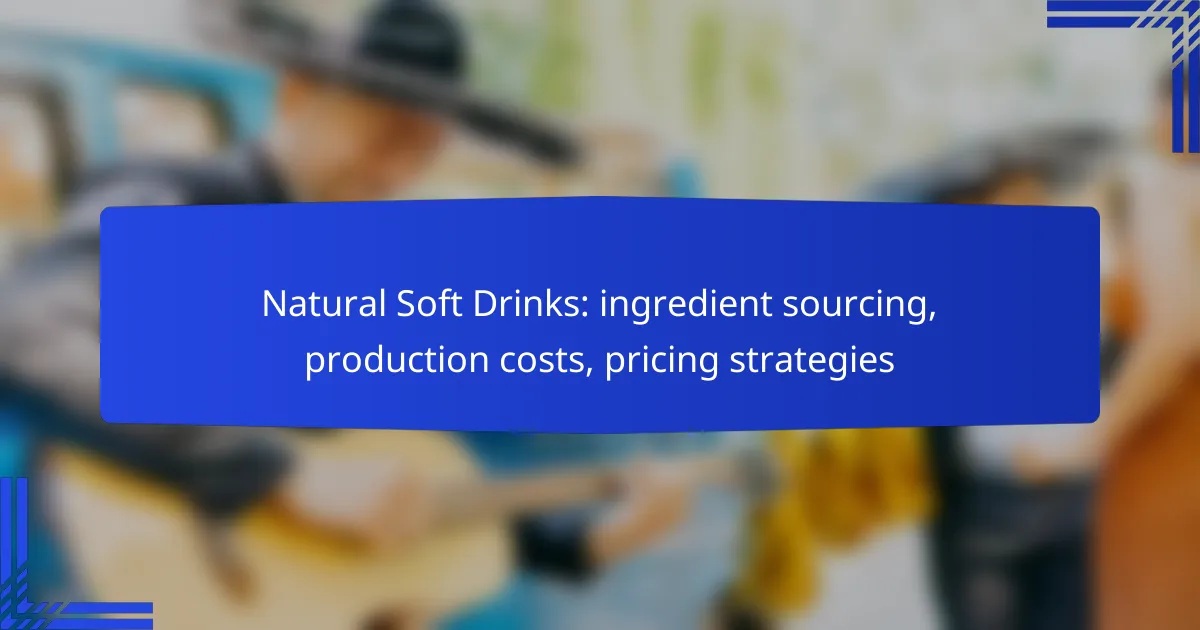Natural soft drinks have gained popularity in Australia due to their emphasis on quality ingredients and health-conscious appeal. Sourced primarily from local suppliers, these beverages leverage fresh, organic produce, supporting local farmers while ensuring superior flavor. However, production costs can fluctuate based on various factors, making it crucial for brands to develop effective pricing strategies to remain competitive and profitable.

What are the best natural soft drinks available in Australia?
Some of the best natural soft drinks in Australia include Bundaberg Ginger Beer, Mount Franklin Sparkling Water, and Pressed Juices. These beverages are popular for their quality ingredients and refreshing flavors, appealing to health-conscious consumers.
Bundaberg Ginger Beer
Bundaberg Ginger Beer is a well-known Australian beverage made from real ginger root, sugar, and natural flavors. It is brewed using traditional methods, which gives it a distinct, spicy taste that sets it apart from mass-produced soft drinks.
This drink is often enjoyed on its own or used as a mixer in cocktails. Bundaberg Ginger Beer is available in various sizes, with prices typically ranging from AUD 2 to AUD 5 per bottle, depending on the retailer.
Mount Franklin Sparkling Water
Mount Franklin Sparkling Water is a popular choice for those seeking a refreshing, calorie-free beverage. Sourced from natural springs in Australia, this sparkling water is known for its clean taste and effervescence.
It is available in various packaging options, including convenient single-serve bottles and larger multi-packs. Prices usually range from AUD 1.50 to AUD 3 per bottle, making it an affordable option for hydration without added sugars or artificial ingredients.
Pressed Juices
Pressed Juices offers a range of cold-pressed juice blends that are both nutritious and flavorful. These juices are made from fresh fruits and vegetables, ensuring that they retain maximum nutrients and taste.
Commonly found in health food stores and online, Pressed Juices typically range from AUD 5 to AUD 10 per bottle, depending on the blend and size. They are a great option for those looking to incorporate more vitamins and minerals into their diet while enjoying a delicious drink.

How are natural soft drinks sourced in Australia?
Natural soft drinks in Australia are primarily sourced from local suppliers who provide fresh, organic ingredients. This focus on local sourcing not only supports Australian farmers but also ensures the drinks are made with high-quality, seasonal produce.
Local fruit suppliers
Local fruit suppliers play a crucial role in the sourcing of ingredients for natural soft drinks. They offer a variety of fruits such as oranges, lemons, and berries, which are essential for flavoring. Working with nearby farms can reduce transportation costs and environmental impact, making it a sustainable choice.
When selecting local suppliers, consider their farming practices and certifications. Many Australian fruit suppliers adhere to strict quality standards, ensuring that the produce is fresh and free from harmful pesticides. Establishing strong relationships with these suppliers can lead to better pricing and reliable supply chains.
Organic ingredient sourcing
Organic ingredient sourcing is vital for producing natural soft drinks that meet consumer demand for healthier options. Ingredients such as cane sugar, herbs, and spices should be certified organic to ensure they are grown without synthetic fertilizers or pesticides. This not only enhances the product’s appeal but also aligns with health-conscious consumer trends.
When sourcing organic ingredients, look for suppliers who provide transparency about their farming practices and certifications. It’s beneficial to compare prices and quality among different suppliers, as organic ingredients can vary significantly in cost. Additionally, consider seasonal availability, as this can affect both pricing and flavor profiles in your soft drinks.

What are the production costs of natural soft drinks?
The production costs of natural soft drinks can vary significantly based on ingredient sourcing, labor, and packaging. Understanding these components is essential for pricing strategies and maintaining profitability in a competitive market.
Ingredient costs
Ingredient costs are a major factor in the overall production expenses of natural soft drinks. Sourcing high-quality, organic ingredients often leads to higher prices, which can range from moderate to substantial depending on the supplier and the specific components used, such as fruit extracts or natural sweeteners.
For example, organic cane sugar may cost more than conventional sugar, impacting the final product’s price. It’s crucial to balance quality with cost to ensure the product remains appealing to consumers while maintaining a healthy margin.
Labor costs
Labor costs encompass wages, benefits, and overhead associated with production staff. In regions with higher minimum wage laws or stringent labor regulations, these costs can significantly affect the overall budget for natural soft drink production.
Employing skilled workers for quality control and production efficiency can lead to better product outcomes but may also increase labor expenses. Companies should consider investing in training to enhance productivity and reduce turnover, which can help manage these costs effectively.
Packaging expenses
Packaging expenses are another critical component of production costs for natural soft drinks. Sustainable packaging options, such as biodegradable or recyclable materials, often come at a premium compared to traditional packaging. However, they can attract environmentally conscious consumers.
It’s essential to evaluate the trade-offs between cost and consumer appeal when selecting packaging. Companies should also consider bulk purchasing to reduce per-unit costs and explore innovative designs that enhance shelf appeal without significantly increasing expenses.

What pricing strategies are effective for natural soft drinks?
Effective pricing strategies for natural soft drinks include premium pricing and value-based pricing. These approaches help businesses align their prices with consumer perceptions and market demand, ensuring profitability while appealing to health-conscious customers.
Premium pricing model
The premium pricing model involves setting higher prices for natural soft drinks to reflect their quality and unique ingredients. This strategy is often used by brands that emphasize organic sourcing, artisanal production methods, or distinctive flavors.
When implementing a premium pricing strategy, consider factors such as production costs, target demographics, and market positioning. For instance, natural soft drinks priced in the range of $3 to $5 per bottle can attract consumers willing to pay more for perceived health benefits and superior taste.
However, be cautious of overpricing, as it may alienate potential customers. Conduct market research to ensure your pricing aligns with consumer expectations and competitor offerings.
Value-based pricing
Value-based pricing focuses on setting prices based on the perceived value to the consumer rather than solely on production costs. This strategy requires a deep understanding of customer preferences and the benefits they associate with natural soft drinks.
To effectively implement value-based pricing, gather feedback from your target audience to identify what they value most—such as health benefits, sustainability, or unique flavors. Prices can then be adjusted accordingly, potentially ranging from $2 to $4 per bottle, depending on the perceived value.
Keep in mind that this approach may require ongoing adjustments as consumer preferences evolve. Regularly assess market trends and customer feedback to stay competitive and relevant in the natural soft drink market.

What are the consumer trends in natural soft drinks?
Consumer trends in natural soft drinks indicate a growing preference for healthier, more sustainable beverage options. As awareness of health and environmental issues rises, many consumers are gravitating towards drinks that are perceived as natural and free from artificial ingredients.
Health-conscious choices
Health-conscious consumers are increasingly opting for natural soft drinks that contain fewer calories, no added sugars, and organic ingredients. This shift is driven by a desire for beverages that support overall wellness and align with dietary preferences, such as low-carb or vegan diets.
Brands are responding by reformulating their products to include functional ingredients like probiotics, vitamins, and antioxidants. For example, drinks enriched with vitamin C or herbal extracts are becoming popular, appealing to those looking for added health benefits.
Preference for local brands
Consumers are showing a strong preference for local brands, often favoring products that are sourced and produced within their own communities. This trend is fueled by a desire to support local economies and reduce carbon footprints associated with transportation.
Local brands typically emphasize transparency in sourcing and production, which resonates with consumers seeking authenticity. Many local producers highlight their use of regional ingredients, which can enhance flavor and appeal to those interested in unique, culturally relevant options.

How do regulations impact natural soft drink production?
Regulations significantly influence natural soft drink production by establishing standards for safety, quality, and labeling. Compliance with these regulations is essential for market access and consumer trust.
Food safety standards
Food safety standards dictate the acceptable levels of contaminants and the hygiene practices required during production. For natural soft drinks, this includes ensuring that ingredients are sourced from approved suppliers and that manufacturing facilities meet health regulations.
Producers must regularly test their products for microbial contamination and chemical residues. Adhering to these standards can prevent costly recalls and protect brand reputation.
Labeling requirements
Labeling requirements for natural soft drinks mandate clear and accurate information about ingredients, nutritional content, and allergens. This transparency helps consumers make informed choices and fosters trust in the brand.
In many regions, labels must include details such as the percentage of natural ingredients and any artificial additives. Failure to comply with labeling regulations can lead to fines and legal issues, so it is crucial for producers to stay updated on local laws.

What are the marketing strategies for natural soft drinks?
Marketing strategies for natural soft drinks focus on building brand awareness and promoting health benefits through targeted outreach. These strategies often leverage digital platforms, community engagement, and unique selling propositions to attract health-conscious consumers.
Social media campaigns
Social media campaigns are essential for promoting natural soft drinks, as they allow brands to connect directly with their target audience. Platforms like Instagram and Facebook are particularly effective for showcasing vibrant product imagery and engaging storytelling that highlights the natural ingredients and health benefits.
Brands should create visually appealing content that resonates with health-conscious consumers, using hashtags and challenges to increase visibility. Collaborating with influencers who align with the brand’s values can also enhance credibility and reach.
To maximize impact, brands should track engagement metrics and adjust their strategies based on audience feedback. Regularly posting user-generated content can foster community and encourage brand loyalty.
